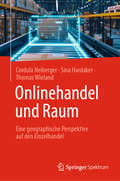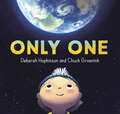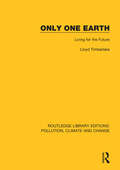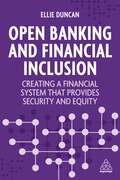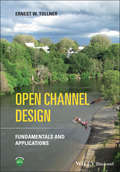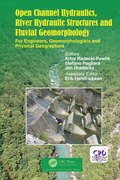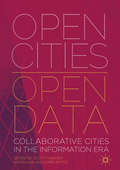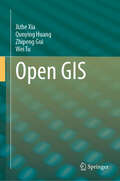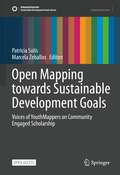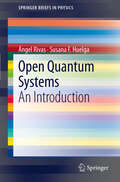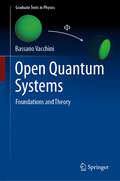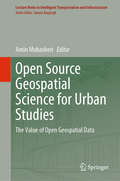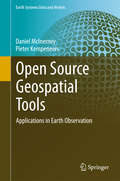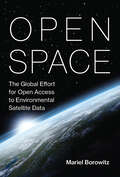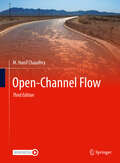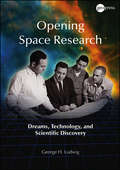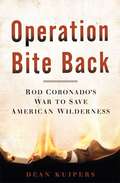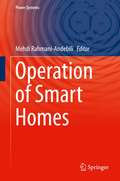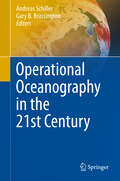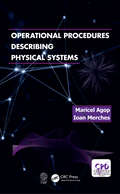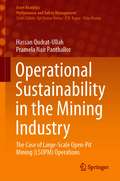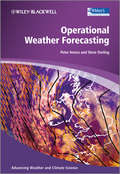- Table View
- List View
Onlinehandel und Raum: Eine geographische Perspektive auf den Einzelhandel
by Cordula Neiberger Thomas Wieland Sina HardakerIn einer Zeit rasanter technologischer Veränderungen und der sich wandelnden Konsumlandschaften bietet „Onlinehandel und Raum. Eine geographische Perspektive auf den Einzelhandel“ eine zeitgemäße Analyse der Verschmelzung von digitalem Handel und geographischen Räumen. Dieses Buch beleuchtet, wie der Onlinehandel die traditionellen Konzepte von Markt, Ort und Zugänglichkeit neu definiert und reorganisiert und welche räumlichen Auswirkungen diese Entwicklungen auf Städte und ländliche Regionen haben. Die Beiträge in diesem Band reichen von digitalen Plattformen bis hin zu Verbrauchermustern und Stadtplanung und bieten wichtige Einblicke in die geographischen Dimensionen des Onlinehandels. Es adressiert Forschende, Praktiker, Studierende und Entscheidungsträger gleichermaßen. Dabei werden sowohl theoretische als auch praktische Ansätze behandelt, um ein umfassendes Verständnis der Thematik zu gewährleisten. Durch Fallstudien und empirische Untersuchungen werden konkrete Beispiele und innovative Lösungen präsentiert.
Only One
by Deborah HopkinsonThis lyrical, environmentally focused picture book showcases the unique beauty of our one and only universe--its galaxies, stars, and planets--as well as our one and only Earth and the precious life it contains. Join one girl as she leads her friends to a tree-planting ceremony. Along the way, she explains in simple language the value of the universe and Planet Earth. Readers will see the Big Bang, the Milky Way, all the planets in the solar system, as well as Earth's atmosphere, and the life within it: its oceans, trees, bugs, and seven billion human beings. Finally, the girl and her friends plant a tree--doing one small thing to help their one special planet. Both informative and inspiring, here is a beautifully written and gorgeously illustrated science picture book about our universe that will encourage young readers and listeners to protect and preserve the environment.
Only One Earth: Living for the Future
by Lloyd TimberlakeOriginally published in 1987, this book showcases global examples of people and communities who are learning to use the world’s resources without despoiling them for future generations. It includes chapters on nomadic life in Kenya, food supply in a Peruvian shantytown and a Buddhist monk in Sri Lanka who advises about tree planting and watersheds. Amidst climate change and environmental destruction this book looks at the world through the eyes of the people who tend it and finds hope in their growing understanding of their environment and in their willingness to live within the Earth’s resources.
Open Banking and Financial Inclusion: Creating a Financial System That Provides Security and Equity
by Ellie DuncanOpen Banking and Financial Inclusion enables readers to make informed decisions about open banking. Open Banking creates opportunities to develop more innovative products, increase customer satisfaction, and has the potential to open up access to financial services to those previously excluded and underbanked. Open Banking and Financial Inclusion reviews the opportunities, realities and limitations of open banking as it pertains to social inclusion, acknowledging the importance of impact and authenticity in ESG actions. It considers whether open banking is really working for the benefit of consumers by speaking to key people across the open banking, fintech and data sharing industry and also explores how banks and fintechs are measuring their social impact. Readers will gain insights from real people about their journey from financial exclusion to inclusion, and the part played by open banking. They will also access case studies offering an in-depth picture of how open banking has developed in both emerging and developed markets and where open banking has been successful in promoting financial inclusion. Open Banking and Financial Inclusion investigates the ultimate intention of open banking and its lead up to open finance.
Open Channel Design: Fundamentals and Applications
by Ernest W. TollnerOPEN CHANNEL DESIGN A fundamental knowledge of flow in open channels is essential for the planning and design of systems to manage water resources. Open channel design has applications within many fields, including civil engineering, agriculture, hydrology, geomorphology, sedimentology, environmental fluid and sediment dynamics and river engineering. Open Channel Design: Fundamentals and Applications covers permissible velocity, tractive force, and regime theory design methodologies and applications. Hydraulic structures for flow control and measurement are covered. Flow profiles and their design implications are covered. Sediment transport mechanics and moveable boundaries in channels are introduced. Finally, a brief treatment of the St. Venant equations and Navier-Stokes equations are introduced as topics to be explored in more advanced courses. The central goal is to prepare students for work in engineering offices where they will be involved with aspects of land development and related consulting work. Students will also be prepared for advanced courses that will involve computational fluid dynamics approaches for solving 2-d and 3-d problems in advanced graduate level courses. Offering a fresh approach, Open Channel Design: Fundamentals and Applications prepares students for work in engineering offices where they will be involved with aspects of land development and related consulting work. It also introduces the reader to software packages including Mathematica, HecRas and HY8, all widely used in professional settings.
Open Channel Hydraulics, River Hydraulic Structures and Fluvial Geomorphology: For Engineers, Geomorphologists and Physical Geographers
by Artur Radecki-Pawlik Stefano Pagliara Jan HradeckyThis book presents practical hydraulic and river engineering research along with fluvial geomorphological concepts, and links the theoretical and practical knowledge of people working every day with rivers, streams, and hydraulic structures to fluvial geomorphology. Besides providing a guide for professionals, this book also provides material for students to acquire the knowledge and skills to rehabilitate rivers, streams, and waterways.
Open Cities | Open Data: Collaborative Cities in the Information Era
by Hoon Han Scott Hawken Christopher PetitToday the world’s largest economies and corporations trade in data and its products to generate value in new disruptive markets. Within these markets vast streams of data are often inaccessible or untapped and controlled by powerful monopolies. Counter to this exclusive use of data is a promising world-wide “open-data” movement, promoting freely accessible information to share, reuse and redistribute. The provision and application of open data has enormous potential to transform exclusive, technocratic “smart cities” into inclusive and responsive “open-cities”.This book argues that those who contribute urban data should benefit from its production. Like the city itself, the information landscape is a public asset produced through collective effort, attention, and resources. People produce data through their engagement with the city, creating digital footprints through social medial, mobility applications, and city sensors. By opening up data there is potential to generate greater value by supporting unforeseen collaborations, spontaneous urban innovations and solutions, and improved decision-making insights. Yet achieving more open cities is made challenging by conflicting desires for urban anonymity, sociability, privacy and transparency. This book engages with these issues through a variety of critical perspectives, and presents strategies, tools and case studies that enable this transformation.
Open GIS
by Qunying Huang Jizhe Xia Zhipeng Gui Wei TuThis book provides a comprehensive introduction about recent state-of-the-art advancements in Open GIS, including Open GIS data, services, software, and libraries for GIS programming. Though GIS software has entered the era of Open GIS alongside the emerging trend of open source software, there is no suitable book for GIS educators to teach our next generation, and for professionals to gain an in-depth understanding about Open GIS technologies and toolkits. This book intends to provide this missing guidance for students, educators and professionals in geospatial fields to quickly find, learn and use a wide arrange of open-sourced data, tools, and programming for geospatial applications. The book begins with an introduction to open data, and discusses data management solutions, including both open-sourced relational databases and NoSQL database systems for big data. Next, the book covers different GIS and remote sensing software, tools and programminglibraries to perform spatial statistics and analyses. Readers will learn about the tools and libraries for desktop and web GIS development for both two dimensional (2D) and three dimensional (3D) mapping and visualization. Finally, the book provides two example of Open GIS applications including public health and natural hazards. At the end of each chapter, practical hands-on exercises are included for readers to fully master the most popular Open GIS technologies introduced in the chapter.
Open Mapping towards Sustainable Development Goals: Voices of YouthMappers on Community Engaged Scholarship (Sustainable Development Goals Series)
by Patricia Solís Marcela ZeballosThis collection amplifies the experiences of some of the world’s young people who are working to address SDGs using geospatial technologies and multi-national collaboration. Authors from every region of the world who have emerged as leaders in the YouthMappers movement share their perspectives and knowledge in an accessible and peer-friendly format. YouthMappers are university students who create and use open mapping for development and humanitarian purposes. Their work leverages digital innovations - both geospatial platforms and communications technologies - to answer the call for leadership to address sustainability challenges. The book conveys a sense of robust knowledge emerging from formal studies or informal academic experiences - in the first-person voices of students and recent graduates who are at the forefront of creating a new map of the world. YouthMappers use OpenStreetMap as the foundational sharing mechanism for creating data together. Authors impart the way they are learning about themselves, about each other, about the world. They are developing technology skills, and simultaneously teaching the rest of the world about the potential contributions of a highly connected generation of emerging world leaders for the SDGs. The book is timely, in that it captures a pivotal moment in the trajectory of the YouthMappers movement’s ability to share emerging expertise, and one that coincides with a pivotal moment in the geopolitical history of planet earth whose inhabitants need to hear from them. Most volumes that cover the topic of sustainability in terms of youth development are written by non-youth authors. Moreover, most are written by non-majoritarian, entrenched academic scholars. This book instead puts forward the diverse voices of students and recent graduates in countries where YouthMappers works, all over the world. Authors cover topics that range from water, agriculture, food, to waste, education, gender, climate action and disasters from their own eyes in working with data, mapping, and humanitarian action, often working across national boundaries and across continents. To inspire readers with their insights, the chapters are mapped to the United Nations 17 Sustainable Development Goals (SDGs) in ways that connect a youth agenda to a global agenda. This is an open access book.
Open Quantum Systems
by Ángel Rivas Susana F. HuelgaIn this volume the fundamental theory of open quantum systems is revised in the light of modern developments in the field. A unified approach to the quantum evolution of open systems is presented by merging concepts and methods traditionally employed by different communities, such as quantum optics, condensed matter, chemical physics and mathematical physics. The mathematical structure and the general properties of the dynamical maps underlying open system dynamics are explained in detail. The microscopic derivation of dynamical equations, including both Markovian and non-Markovian evolutions, is also discussed. Because of the step-by-step explanations, this work is a useful reference to novices in this field. However, experienced researches can also benefit from the presentation of recent results.
Open Quantum Systems: Foundations and Theory (Graduate Texts in Physics)
by Bassano VacchiniThe proposed book is a bridge between the foundations of quantum mechanics and the theory of open quantum systems. The treatment of open quantum systems is a rapidly growing subject, of interest to an ever-increasing number of scientists. The main focus is on overcoming the idealization of perfect isolation of a quantum system, so as to allow for a more realistic treatment and to provide the relevant background for the development of quantum technologies. The book is addressed to students and researchers in the field of open quantum systems and more generally quantum mechanics, a wide community of physicists, mathematicians, and chemists. It is devised both to enter the field and to prepare a series of lectures or a one-semester course on the topic.
Open Source Geospatial Science for Urban Studies: The Value of Open Geospatial Data (Lecture Notes in Intelligent Transportation and Infrastructure)
by Amin MobasheriThis book is mainly focused on two themes: transportation and smart city applications. Open geospatial science and technology is an increasingly important paradigm that offers the opportunity to promote the democratization of geographical information, the transparency of governments and institutions, as well as social, economic and urban opportunities. During the past decade, developments in the area of open geospatial data have greatly increased. The open source GIS research community believes that combining free and open software, open data, as well as open standards, leads to the creation of a sustainable ecosystem for accelerating new discoveries to help solve global cross-disciplinary urban challenges. The vision of this book is to enrich the existing literature on this topic, and act one step towards more sustainable cities through employment of open source GIS solutions that are reproducible. Various contributions are provided and practically implemented in several urban use cases. Therefore, apart from researchers, lecturers and students in the geography/urbanism domain, crowdsourcing and VGI domain, as well as open source GIS domain, it is believed the specialists and mentors in municipalities and urban planning departments as well as professionals in private companies would be interested to read this book.
Open Source Geospatial Tools
by Daniel Mcinerney Pieter KempeneersThis book focuses on the use of open source software for geospatial analysis. It demonstrates the effectiveness of the command line interface for handling both vector, raster and 3D geospatial data. Appropriate open-source tools for data processing are clearly explained and discusses how they can be used to solve everyday tasks. A series of fully worked case studies are presented including vector spatial analysis, remote sensing data analysis, landcover classification and LiDAR processing. A hands-on introduction to the application programming interface (API) of GDAL/OGR in Python/C++ is provided for readers who want to extend existing tools and/or develop their own software.
Open Space: The Global Effort for Open Access to Environmental Satellite Data (Information Policy)
by Mariel BorowitzAn examination of environmental satellite data sharing policies, offering a model of data-sharing policy development, case and practical recommendations for increasing global data sharing.Key to understanding and addressing climate change is continuous and precise monitoring of environmental conditions. Satellites play an important role in collecting climate data, offering comprehensive global coverage that can't be matched by in situ observation. And yet, as Mariel Borowitz shows in this book, much satellite data is not freely available but restricted; this remains true despite the data-sharing advocacy of international organizations and a global open data movement. Borowitz examines policies governing the sharing of environmental satellite data, offering a model of data-sharing policy development and applying it in case studies from the United States, Europe, and Japan—countries responsible for nearly half of the unclassified government Earth observation satellites. Borowitz develops a model that centers on the government agency as the primary actor while taking into account the roles of such outside actors as other government officials and non-governmental actors, as well as the economic, security, and normative attributes of the data itself. The case studies include the U.S. National Aeronautics and Space Administration (NASA) and the U.S. National Oceanographic and Atmospheric Association (NOAA), and the United States Geological Survey (USGS); the European Space Agency (ESA) and the European Organization for the Exploitation of Meteorological Satellites (EUMETSAT); and the Japanese Aerospace Exploration Agency (JAXA) and the Japanese Meteorological Agency (JMA). Finally, she considers the policy implications of her findings for the future and provides recommendations on how to increase global sharing of satellite data.
Open-Channel Flow
by M. Hanif ChaudhryOpen Channel Flow, 2nd edition is written for senior-level undergraduate and graduate courses on steady and unsteady open-channel flow. The book is comprised of two parts: Part I covers steady flow and Part II describes unsteady flow. The second edition features considerable emphasis on the presentation of modern methods for computer analyses; full coverage of unsteady flow; inclusion of typical computer programs; new problem sets and a complete solution manual for instructors.
Opening Space Research: Dreams, Technology, and Scientific Discovery (Special Publications #62)
by George H. LudwigPublished by the American Geophysical Union as part of the Special Publications Series. Opening Space Research: Dreams, Technology, and Scientific Discovery is George Ludwig's account of the early development of space-based electromagnetic physics, with a focus on the first U.S. space launches and the discovery of the Van Allen radiation belts. Narrated by the person who developed many of the instruments for the early Explorer spacecraft during the 1950s and participated directly in the scientific research, it draws heavily upon the author's voluminous collection of laboratory notes and other papers, upon the Van Allen archive, and upon a wide array of other sources. This book presents very detailed discussions of historic events in a highly readable (semitechnical), first-person form. More than that, though, Opening Space Research brings to the forefront the entire team of scientists who made these accomplishments possible, providing an extensive index of names to enhance and complete the historical record. Authoritative and unique, this book will be of interest to space scientists, science historians, and anyone interested in space history and the first U.S. space launches.
Opening a Window to the West
by Peter EnnalsAfter more than two centuries of self-seclusion, Japan finally opened itself to Western traders and influences in the 1850s. However, Westerners were restricted to a handful of Foreign Concessions set adjacent to selected Japanese cities, where they could fashion a working urban space suited to their own cultural patterns, and which provided the Japanese with a microscopic lens on Western ways of behaviour and commerce. Kōbe was one of these treaty ports, and its Foreign Concession, along with that at Yokohama, became the most vibrant and successful of these settlements.The first book-length study of Kōbe's Foreign Concession, Opening a Window to the West situates Kōbe within the larger pattern of globalization occurring throughout East Asia in the nineteenth century. Detailing the form and evolution of the settlement, its social and economic composition, and its specific mercantile trading features, this vivid micro-study illuminates the making of Kōbe during these critical decades of growth and development.
Opening and Closure of the Neuquén Basin in the Southern Andes (Springer Earth System Sciences)
by Andrés Folguera Diego KietzmannThis book provides an overview of newly gathered material focusing on the opening and closure of The Neuquén Basin. The Neuquén Basin contains the most important hydrocarbon reservoirs in Argentina and therefore is characterized by a profound knowledge of the sedimentation mechanisms and closure times. During the last 10 years a considerable amount of new information has been produced that illustrates a complex evolution that involves more than one synrift stage during its evolution, an aborted sag phase associated with the inception of a first foreland basin in late Early Cretaceous times, two extensional destabilizations in the Late Cretaceous-Paleocene and late Oligocene times and a Neogene magmatic expansion coetaneous to a last mountain building. These processes have produced a polyphasic complex structure that exhumed the rich sedimentary record that characterizes the basin.
Operation Bite Back: Rod Coronado's War to Save American Wilderness
by Dean KuipersAs the environmental movement gains followers and momentum, Kuipers presents an insider's look at its radical wing and its uneasy relationship with the mainstream.
Operation of Smart Homes (Power Systems)
by Mehdi Rahmani-AndebiliThis book presents the latest research advancements in the operation of smart homes. It comprises new operation techniques including cooperative distributed energy scheduling, framework to react to malicious cyberattacks, framework for demand-side management, and framework for the design of smart homes to support residents’ wellness as well as new optimization techniques such as stochastic model predictive control and multi-time scale optimization. In addition, the book analyzes 11,000 studies that have been indexed in scientific databases and categorizes them based on various data points, including the field and the subject of the research, the name of the institutions, and the nationality of the authors.Presents new operation techniques of smart homes;Introduces new optimization techniques for operation of smart homes;Analyses 11,000 studies and categorizes them based on different data points.
Operation: Unlocking Earth's Geologic Mysteries
by The JASON ProjectDeveloped by JASON Learning - in partnership with the National Geographic Society, NOAA, the Smithsonian Institution, and the U.S. Department of Energy - Geology: Tectonic Fury takes students on a journey to examine the geologic forces at work on our planet. Students work alongside leading researchers to investigate Earth's icy peaks, liquid metal core, and strange and beautiful landforms. Geology affects so many aspects of our lives, from energy production to the food we grow. Understanding the structure of Earth, its history, and the processes that act on is vital for our survival. Geology: Tectonic Fury explains key concepts related to geology - including rocks and minerals, the rock cycle, weathering and erosion, soil, Earth's history, fossils, plate tectonics, earthquakes, and volcanoes - in an engaging and exciting format. With 134 pages of breathtaking, full-color images, Geology: Tectonic Fury is sure to captivate curious minds. JASON Learning curricula are designed to be incorporated into upper elementary, middle school, and high school classrooms and other formal and informal learning environments. Content is rigorously aligned to national and state science standards as well as Common Core mathematics and English language arts standards. In addition to the engaging reading selections and integration of real-world scientists and their work, all JASON curricula include hands-on activities and labs that can be performed easily with limited resources. Optional JASON Online Access (purchased separately) brings content to life with a host of additional features on JASON's gated website including read-to-me functionality, scientist profiles, on-demand videos, and award-winning interactive games.
Operational Oceanography in the 21st Century
by Andreas Schiller Gary B. BrassingtonOver the past decade the significant advances in real-time ocean observing systems, ocean modelling, ocean data assimilation and super-computing has seen the development and implementation of operational ocean forecast systems of the global ocean. At the conclusion of the Global Ocean Data Assimilation Experiment (GODAE) in 2008 ocean analysis and forecasting services were being supported by 12 international centres. This book is about ocean forecasting - a maturing field which remains an active area of research, and includes such topics as ocean predictability, observing system design, high resolution ocean modelling and ocean data assimilation. It presents the introduction to ocean forecasting which provides a foundation for new opportunities in areas of coupled bio-geochemical forecasting and coupled atmosphere-wave-ocean forecasting. The book describes an updated account of research and development to improve forecast systems, determining how best to service the marine user community with forecast information as well as demonstrating impact to their applications. It also discusses operational centres that are now supporting a range of real-time ocean services including online graphical and data products for their user communities and their feedback on the quality of information. The contents of this book are aimed at early career scientists and professionals with an interest in operational oceanography and related ocean science. There are excellent opportunities for exciting careers in the emerging field of operational oceanography in order to address current and future challenges as well as provide the supporting services to a rapidly growing user community.
Operational Procedures Describing Physical Systems
by Ioan Merches Marciel AgopThe authors examine topics in modern physics and offer a unitary and original treatment of the fundamental problems of the dynamics of physical systems, as well as a description of the nuclear matter within a framework of general relativity. They show that some physical phenomena studied at two different resolution scales (e.g. microscale, cosmological scale), apparently with no connection between them, become compatible by means of the operational procedures, acting either as some ”hidden” symmetries, or harmonic-type mappings. The book is addressed to the students, researchers and university/high school teachers working in the fields of mathematics, physics, and chemistry.
Operational Sustainability in the Mining Industry: The Case of Large-Scale Open-Pit Mining (LSOPM) Operations (Asset Analytics)
by Hassan Qudrat-Ullah Pramela Nair PanthallorThis book broadly explains the requirement to focus on core components in a business and provides a case study of open-pit mining operations throughout the book to understand the management perspective of large organizations. With globalized approaches of large businesses and the rising requirement of understanding the needs of modern organizations, it is necessary to focus on key areas of businesses to ensure sustainability of operations. Organizations look into achieving a high return on investments and short-term measures in increasing sales or revenue is considered unsuitable. It is a necessity to look for sustainability and continuous methods of innovation to boost efficiency. This book provides a case study based on large organizations and uses qualitative methodologies where data was collected using in-depth interviews of respondents from various mining companies in the top and middle-level management from different parts of the world, detailing the state of the art of information systems currently used in large scale open-pit miming (LSOPM). This book provides a sound knowledge of cutting-edge factors to the reader for managing the business to attain operational excellence and long-term sustainability, and caters to a broad spectrum of management and technical readers.
Operational Weather Forecasting
by Peter Michael Inness Steve DorlingThis book offers a complete primer, covering the end-to-end process of forecast production, and bringing together a description of all the relevant aspects together in a single volume; with plenty of explanation of some of the more complex issues and examples of current, state-of-the-art practices.Operational Weather Forecasting covers the whole process of forecast production, from understanding the nature of the forecasting problem, gathering the observational data with which to initialise and verify forecasts, designing and building a model (or models) to advance those initial conditions forwards in time and then interpreting the model output and putting it into a form which is relevant to customers of weather forecasts. Included is the generation of forecasts on the monthly-to-seasonal timescales, often excluded in text-books despite this type of forecasting having been undertaken for several years.This is a rapidly developing field, with a lot of variations in practices between different forecasting centres. Thus the authors have tried to be as generic as possible when describing aspects of numerical model design and formulation. Despite the reliance on NWP, the human forecaster still has a big part to play in producing weather forecasts and this is described, along with the issue of forecast verification - how forecast centres measure their own performance and improve upon it.Advanced undergraduates and postgraduate students will use this book to understand how the theory comes together in the day-to-day applications of weather forecast production. In addition, professional weather forecasting practitioners, professional users of weather forecasts and trainers will all find this new member of the RMetS Advancing Weather and Climate series a valuable tool. Provides an end-to-end description of the weather forecasting processClearly structured and pitched at an accessible level, the book discusses the practical choices that operational forecasting centres have to make in terms of what numerical models they use and when they are run.Takes a very practical approach, using real life case-studies to contextualize informationDiscusses the latest advances in the area, including ensemble methods, monthly to seasonal range prediction and use of 'nowcasting' tools such as radar and satellite imageryFull colour throughoutWritten by a highly respected team of authors with experience in both academia and practice.Part of the RMetS book series 'Advancing Weather and Climate'
